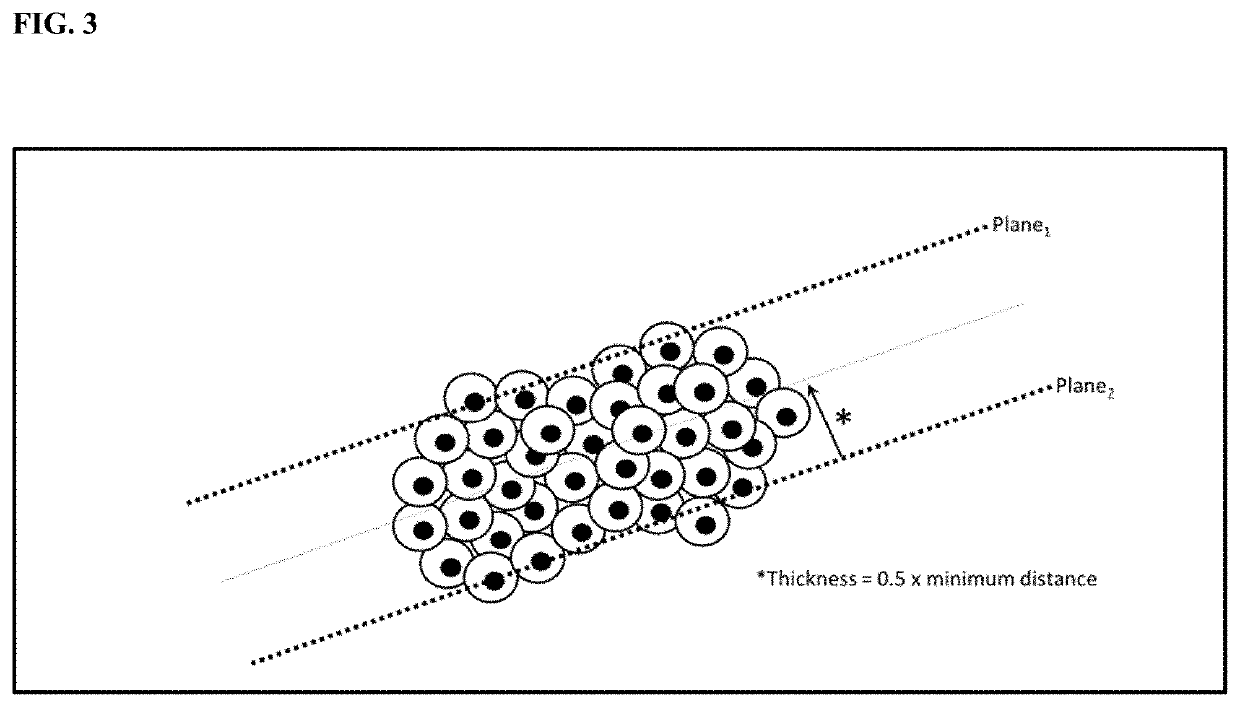Compositions and methods for increasing the culture density of a cellular biomass within a cultivation infrastructure
a technology of cellular biomass and cultivation infrastructure, which is applied in the direction of skeletal/connective tissue cells, peptide sources, peptides, etc., can solve the problems of limiting the final yield, limiting the mass production of cellular biomass originating from culture, and limiting cell growth, so as to increase the growth rate of cellular biomass, increase cell proliferation within the cellular biomass, and increase the survival of the cellular biomass
- Summary
- Abstract
- Description
- Claims
- Application Information
AI Technical Summary
Benefits of technology
Problems solved by technology
Method used
Image
Examples
example 1
g the Thickness of Biomass Cultivated on a Substrate
[0169]One protocol for increasing the thickness of a biomass cultivated on a substrate comprises 7 steps: (1) transfect an anchorage-dependent, bovine myoblasts with a construct expressing YAP1 or TAZ under the control of a doxycycline-inducible eukaryotic promoter and containing an antibiotic-resistance gene; (2) select and enrich the transfected cells with a dosage of antibiotic lethal to the non-transfected cells; (3) passage the cells to a cultivation substrate supporting cell adhesion, and cultivating the cells to super-confluence in a proliferation medium, and for four additional days after the cells become super confluent, with daily culture media changes; in the presence of doxycycline; (4) aspirate the liquid proliferation medium from the cell biomass; (5) add liquid differentiation medium to the cell biomass, omitting doxycycline and differentiate the biomass into skeletal muscle over the course of four days, with daily m...
example 2
Anchorage-Dependent Cells for Cultivation in Suspension
[0170]Anchorage-dependent cells can be adapted for cultivation in suspension, and can include at least the following steps: (1) transfect an anchorage-dependent, chicken myoblasts with a construct expressing YAP1 or TAZ under the control of a doxycycline-inducible eukaryotic promoter and containing an antibiotic-resistance gene; (2) select and enrich the transfected cells with a dosage of antibiotic lethal to the non-transfected cells; (3) passage the cells in a single-cell suspension to a shaker flask in proliferation medium supplemented with doxycycline, and shake flask in a slow, orbital motion sufficient to prevent the cells from sedimentation within the flask and keep cells in suspension; (4) clonally isolate proliferating cells from the suspension culture and passage to another suspension culture, as described in step no. 3 for scaling the cultivation of biomass, or into an anchorage-dependent culture, as described in Exam...
example 3
of Primary Cells from a Metazoan Source
[0171]Protocol #1:
[0172]Prior to isolation of cells, a 150 cm2 flask (T-150 flask) was prepared for cell attachment by dispersal of a 10 mL of a peptide solution (e.g. 0.1% gelatin) into the flask and incubating the flask for at least 1 hour at 37° C. The aqueous peptide solution was aspirated from the T-150 flask and the flask was rinsed with phosphate-buffered saline. 25 mL of growth medium was formulated to support proliferation of the cell type isolated. For example, a growth medium comprising Dulbecco's Modified Eagle Medium+10% bovine serum, was added to the flask and the flask was incubated and equilibrated under standard culture conditions, such as about 37° C. in 5% atmospheric CO2.
[0173]Under aseptic conditions, a bovine skeletal muscle tissue was excised with dissection instruments. Viable metazoan tissues were harvested and minced into approximately 2 mm×2 mm sections. 150 mg tissue sections were weighed and then transferred to a st...
PUM
| Property | Measurement | Unit |
|---|---|---|
| density | aaaaa | aaaaa |
| thickness | aaaaa | aaaaa |
| density | aaaaa | aaaaa |
Abstract
Description
Claims
Application Information
 Login to View More
Login to View More - R&D
- Intellectual Property
- Life Sciences
- Materials
- Tech Scout
- Unparalleled Data Quality
- Higher Quality Content
- 60% Fewer Hallucinations
Browse by: Latest US Patents, China's latest patents, Technical Efficacy Thesaurus, Application Domain, Technology Topic, Popular Technical Reports.
© 2025 PatSnap. All rights reserved.Legal|Privacy policy|Modern Slavery Act Transparency Statement|Sitemap|About US| Contact US: help@patsnap.com



